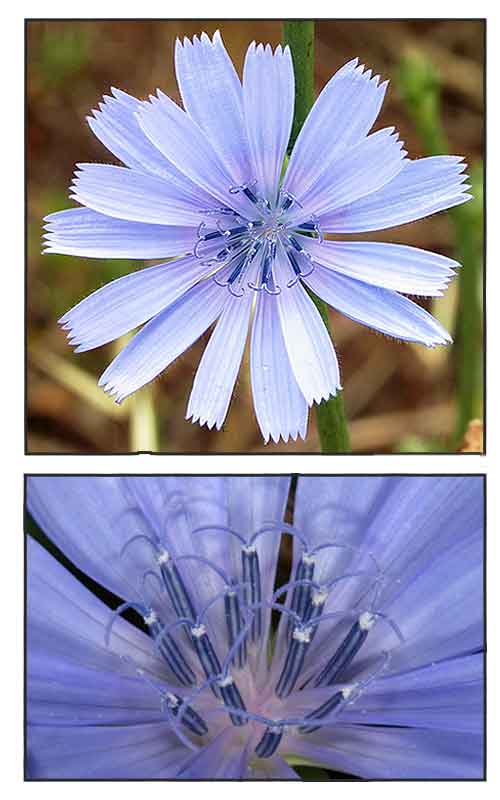 Gen info
Gen info
- The genus Cichorium (Asteraceae) is made up of six species. Cichorium intybus, commonly known as chicory is well known as a coffee substitute. In the 1970s, the root of C. intybus was discovered to contain 40% inulin with potential utility in diabetes. Today, it is grown for the production of inulin on an industrial scale. (7)
- Etymology: Its etymology derives from both Greek and Latin: Cichorium means "field" while intybus is partly Greek meaning "to cut" referring to the leaves and Latin tubus referring to the hollow stem. (7)
-
Radicchio looks like red or purple cabbage or lettuce from the Brassica group of vegetables. Rather, it is a quick growing red-colored leafy chicory vegetable belonging to the Asteraceae family and the genus Cichorium.
- Leaf chicory: Chicory cultivated for its leaves is classified into three types, each with many varieties: (1) Radicchio, with variegated red or red and green leaves. (2) Whitloof: Belgian endive also called witlof, with small head of cream-colored bitter leaves, and (3) Catalogna chicory, also known as puntarelle, includes a whole subfamily, with varieties from Belgian endive and radicchio.
(4)
- Radicchio
is a form of leaf chicory. Although leaf chicory is often called "endive", true endive (Cichorium endivia) is a separate species in the genus, distinct from Belgian endive. (4)
- Varieties of radicchio derive its names from the region in Italy where it was farmed: Chioggia, Treviso, Treviso tardiivo, Castelfranco. (•)
- According to folklore, long-term use of
chicory as coffee substitute may cause retinal damage, with dimming of vision over time. Scientific literature contains little or no evidence to support or refute this claim. (6)
- Chicory as common name is also used for curly endive (Cichorium endivia),
closely related specie and often confused with Cichorium intybus.
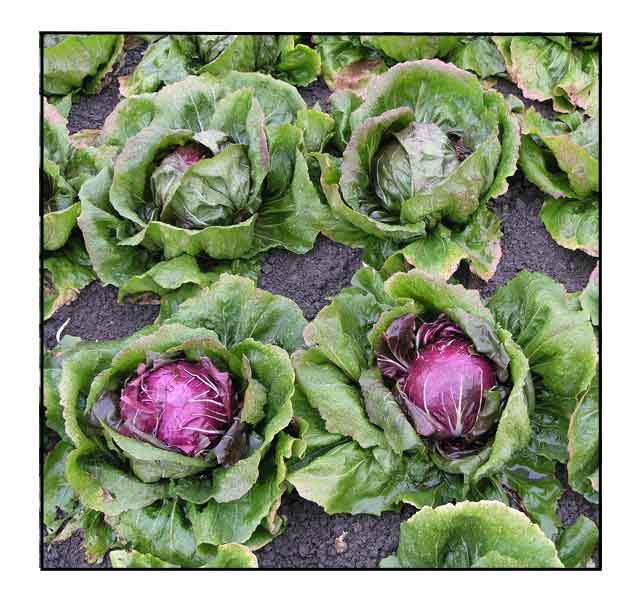 Botany Botany
• Cichorium intybus is a perennial growing 40-110 cm tall, with a strong taproot. Stem usually solitary, erect, branches spreading-ascending, subglabrous. Basal leaves rosulate, obovate to oblanceolate, 15-34 by 2-4 cm, attenuate into a petiole-like basal portion, undivided to usually runcinately pinnatipartite, sparsely covered with long multicellular hairs, base attenuate, margin dentate; lateral lobes 3-6 pairs, triangular; terminal lobe distinctly larger than lateral ones, apex rounded to acute. Stem leaves similar to basal leaves but smaller and less divided. Synflorescence of main axis and larger branches spiciform-paniculiform. Capitula axillary and terminal, solitary or in clusters of a few, sessile or on several cm long, thick, and apically slightly inflated peduncle, with 15-20 florets. Involucre cylindric, 0.9 -1.4 cm. Phyllaries abaxially sparsely with glandular or simple hairs. Florets blue or exceptionally pink or bluish white. Achene brown, subcylindric to obovoid, 2-3 mm, stout, rugulose, apex truncate. Pappus 0.2-0.3 mm. (Flora of China) (8)
Distribution
- Introduced.
-
Cultivated.
- Widely distributed worldwide as native and introduced species.
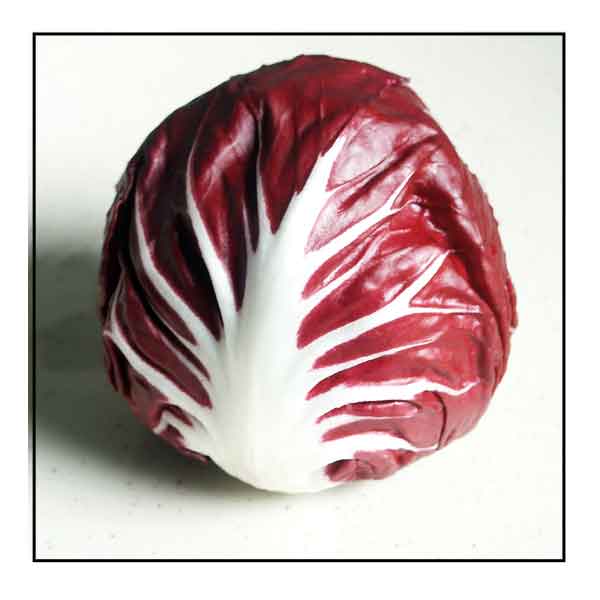 Constituents Constituents
- Nutrient analysis of leaves (cup of shredded radicchio or 40 gm of the vegetable) yield: calories 9.2, protein 0.6 g, total fat 0.1 g, carbohydrate 1.8 g, fiber 0.4 g; (Minerals) calcium 7.6 mg, phosphorus 16.0 mg, magnesium 5.2 mg, iron 0.2 mg, manganese 0.1 mg, copper 0.1 mg, sodium 0 mg, potassium 121 mg, zinc 0.2mg. selenium 0.4 mcg; (Vitamins) B2/riboflavin 0.01 mg, B3 0.1 mg. B5 0.1 mg, B6 0.001 mg, vitamin A 10.8 IU, vitamin C 3.2 mg, vitamin E 0.9 mg, vitamin K 102 mcg, choline 4.4 mg. (5)
- Phytochemical studies of the plant have yielded sesquiterpene lactones (especially lactucin, lactucopicrin, 8-desoxy-lactucin, guaianolid glycosides, including chicoroisides B and C, sonchiside C), caffeic acid derivatives (chiroric acid, chlorogenic acid, isochlorogenic acid, dicaffeoyl tartaric acid), inulin, sugars, proteins, hydroxycoumarins, flavonoids, alkaloids, steroids, terpenoids, oils, volatile compounds, coumarins, vitamins, and polyynes. (8)
- Seeds have yielded chicoridiol, intybusoloid, lupeol, friedelin, ß-sitosterol, stigmasterol, betulinic acid, betulin, betulinaldehyde, syringic acid, vanillic acid. (8)
- Study of roots, leaves, and flowers for biochemical composition (%) revealed per 100 g/dry weight:
Dry matter 98.01, 94.11, and 92.1; moisture 42, 17, 67; crude protein 5.94, 14.16, 15.6; crude fat 17, 19, 27, crude fiber 28.28, 17.59, 20.2; total ash 7.99, 19.2, and 12.5, respectively. Study of methanol, ethanol, n-hexane and chloroform extracts of roots all yielded phenols, flavonoids, tannins, and alkaloids; and saponins only in methanol, n-hexane, and chloroform extracts.
(see study below) (16)
- Study of aerial parts for essential oil
yielded 14 constituents representing 100% of total components, with hexadecanoic acid (32.9%), nonadecane (26.1%) and trans-α-bergamotene (14.0%) as main components. (17)
Properties
- Studies have suggested antibacterial, antitumor, immunological, wound healing, cardioprotective, analgesic, antioxidant, sedative, antioxidant, antidiabetic, hepatoprotective, anti-inflammatory, antimalarial properties.
Parts used
Leaves, roots, seeds, aerial parts.
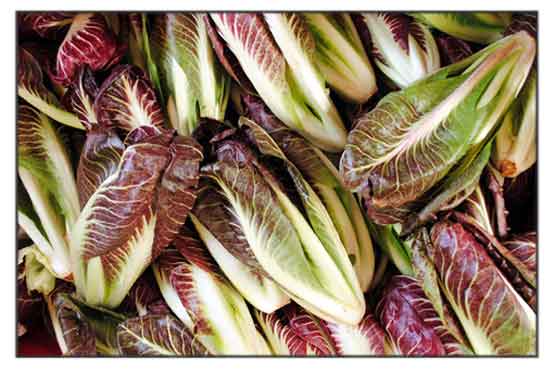 Uses Uses
Edibility
- Leaves are edible, raw or cooked; rather bitter, especially when the plant is flowering. (3)
- Flowers are eaten raw; an attractive addition to salads, though rather bitter. (3)
- Roots cooked like parsnip; boiled young roots are rather palatable. (3)
- As with all chicories, roots after roasting and grinding, can be used as coffee substitute or additive. (6)
Folkloric
- Pliny the Elder (AD 23-79), a Roman naturalist and author of Naturalis Historia, wrote of radicchio as a blood purifier and an aid for insomniacs. (4)
- In ancient Egypt, cultivated as a medicinal plant.
- Plant has been used traditionally for treatment of diarrhea, to strengthen the prostate and other reproductive organs, for the treatment of lung diseases, cough, cancer, hangovers, flatulence, loss of appetite. Also used for sore throat, hemorrhoids, tuberculosis, abdominal cramps, melancholy, deafness, rashes, and as a laxative for children.
(8)
Others
- Ethnoveterinary: Studies have suggested ingestion of chicory by farm animals results in reduction of worm burden, which prompted use as forage supplement. (4)
-
Fodder: "Forage" chicory, initially from wild chicory, has been used to intensify herbage obtainability in perennial pastures for livestock. (9)
Toxicity concern?
• According to folklore, long term use of chicory as coffee substitute nay cause damage to human retinal tissue with consequent dimming of vision However, no scientific study has refuted this folkloric snippet of toxicity. (10)
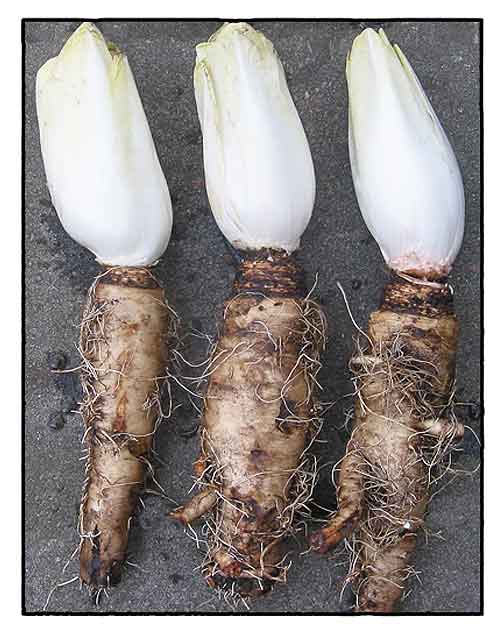 Studies Studies
• Immunological Effect / Seeds: Study evaluated the effects of ethanol extract of C. intybus on the immunotoxicity of alcohol in mice. At a dose of 300 mg/kg orally per day for 28 days along with EtOH showed a significant increase in circulating leukocytes and relative weights of the liver, spleen, and thymus, compared to mice treated with EtOH alone. There was marked enhancement of splenic plaque forming cells, hemagglutination titers to sheep RBCs and secondary IgG antibody response to to bovine serum albumin, among others. Findings indicate the immunotoxicity induced by EtOH is significantly restored or prevented by the extract treatment. (8)
• Cardiovascular Effect: Study of eight varieties of Cichorium intybus on isolated toad's heart showed all varieties have a quinidine-like action, but with variable potency. Chicoric acid along with caffeic acid showed slow vasorelaxant activity against norepinephrine (NE)-induced contraction of rat aorta with/without endothelium. Results suggest inhibition of NE-induced vasoconstriction is due to a decrease in calcium influx from the extracellular space. (8)
• Analgesic and Sedative Effect: Lactucin, lactucopicrin, and 11ß, 13-dihydrolactucin induced analgesic effects in mice by hot plate and tail-flick tests. In the hot plate test, lactucopicrin showed most potency. In the tail-flick tests, all three compounds showed comparable analgesic effects to ibuprofen. Lactucin and lactucopicrin also exhibited sedative effect as evidenced by decreased spontaneous locomotor activity in mice. (8)
• Antioxidant / Seeds: Cichorium intybus seed extract and fractions exhibited good DPPH radical scavenging activity with IC50 ranging from 21.28-72.14 µg/ml. A 100% methanolic extract and ethyl acetate fraction exhibited maximum antioxidant activity. (8)
• Antidiabetic Effect / Leaves: Study the effect of C. intybus leaf powder in minimizing oxidative damage in alloxan-induced diabetic mice. Oxidative damage, impairment of oxidative defense and neuronal activity were investigated in the cerebral hemisphere. Diabetes caused elevation (p<0.001) of blood glucose, protein carboxyl content (PrC) and lipid peroxidation, along with a significant decline in brain level of antioxidant enzyme, catalase (CAT), GSH and AChE showed significant decline in alloxan induced diabetic rats. Feeding with dried powder leaves of C. intybus decreased blood glucose level to near normal and minimized the impairment of oxidative damage. (8)
• Tumor Inhibitory / Roots and Leaves: The crude ethanolic extract of C. intybus roots showed a significant inhibition of Ehrlich tumor carcinoma in mice. with a 70% increase in life span observed with 500 mg/kg/day intraperitoneally. An aqueous-alcoholic macerate of leaves showed antiproliferative effect on amelanotic melanoma C32 cell lines. Magnolialide, a 1ß-hydroxyeudesmanolide isolated from the roots of C. intybus, inhibited several tumor cell lines and induced differentiation of human leukemia HL-60 and U-937 cells. (9)
• Anti-Cancer / Breast Cancer SKBR3 Cell Line / Roots: Study evaluat4ed the effect of methanol extract of root on percentage of survival in SKBR2 human breast cancer cell line. Results showed Cichorium intybus has cytotoxic effects on tumor cells as evidenced by could decreased effect on cell viability. (11)
• In Vitro and In Vivo Anti-Tumor and Antimetastatic Effects: Study evaluated the anti-tumor and antimetastatic effects of C. intybus leaf, stem, and root extracts in vitro and in vivo. Results showed a highly significant inhibition value against 4TI cell line. In an in vivo study on tumor-bearing female Mus musculus Balb/c mice, a leaf extract induced a significant decrease in tumor size (p<0.05). There was little indication of liver metastases in leaf-extract treated animals. (12)
• Nephroprotective / Gentamicin Induced Toxicity / Roots: Study evaluated aqueous and methanolic extracts of roots in gentamicin induced toxicity in rats. Nephroprotective activity was evidenced by decrease in BUN and creatinine. Histopathological examination of the kidney tissues near normal return of structural integrity. (13)
• Hepatoprotective / Carbon Tetrachloride Induced Toxicity: Study evaluated the phytochemical and hepatoprotective activity of various extracts of dried herb of C. intybus L. against carbon tetrachloride (CCl4) intoxicated male albino rats. Silymarin was used as hepato-standard drug. Results showed restoration towards normal values of carbon tetrachloride altered biochemical parameters (ALT, AST. ALP, bilirubin, total protein, γ-GGT), with further substantiation by histopathological examination of liver tissues. (2)
• Hepatoprotective Against Thioacetamide Toxicity: Study evaluated the effects of polyphenolic extracts of Silybum marianum and Cichorium intybus on thioacetamide-induced hepatotoxicity in rat. Results showed significant decrease in activity of aminotransferases, alkaline phosphatase, and bilurubin. The protective effects may be attributed to presence of flavonoid compounds and their antioxidant effects. (15)
• Antimicrobial / Antioxidant / Roots, Leaves, Flowers: Study evaluated roots, leaves, and flower extracts of C. intybus for antimicrobial activities against four bacterial and fungal strains, antioxidant activities (DPPH, ABTS, H2O2 and reducing power assays) and cytotoxicity. Results showed remarkable inhibition of all bacterial and fungal strains tested, with promising antioxidant activities, and cytotoxic activity against brine shrimp lethality assay. Activity was attributed to phenolics and flavonoids. (see constituents above) (16)
• Antidiabetic Effects and Mechanisms: Study reviewed and summarized the clinical aspects and mechanisms of the effects of chicory and its products on the key factors involved in diabetes in different environments. Chicory may be able to affect almost all tissues and organs involved in blood sugar control. Chicory has been shown to (1) inhibit breakdown of disaccharides in the gastrointestinal tract and glucose absorption in the intestine, (2) prevent release of glucose from the liver, (3) increase glucose uptake by the peripheral tissues, especially muscle and liver, (4) stimulate pancreatic insulin secretion, and (5) enhance insulin signaling pathways downstream and reduce diabetic complications. (18)
• Antidiabetic / Toxicity Profile / Seeds: Study evaluated the toxicity profile and antidiabetic, antihyper-lipidemic, and antioxidant efficacy of aqueous extract C. intybus seeds in Wistar rats. UPLC-MS profiling of aqueous extract identified a total of 18 metabolites. Toxicity studies showed no mortality and significant changes in biochemical parameters. Extract treatment attenuated serum glucose and triglyceride levels by 52.7% and 65.3%, respectively, with similar results for parameters related to insulin resistance and oxidative stress. Beneficial effect was confirmed by in silico screening. Results suggest potential as a natural dietary supplement for prevention and treatment of diabetes and as phytopharmaceutical for diabetes. (19)
• Bio-Callus Synthesized Silver Nanoparticles / Antioxidant, Antibacterial, Anticancer / Leaf-Derived Callus: Study reports on the synthesis of silver nanoparticles (Ci-AgNPs) using C. intybus leaf-derived callus extract. Antibacterial activity testing using disc-diffusion method showed distinct zones of inhibition against S. aureus and E. coli. Colorimetric phytochemical analysis revealed higher total phenolic and total flavonoid content. Ci-AgNPs showed high level of antioxidant activity using FRAP and DPPH assays. The Ci-AgNPs showed dose dependent cytotoxicity against MDA-MB231 cells with IC50 of 187.6 µg/mL through induction of apoptosis. Biocompatibility testing showed neglectable cytotoxicity (<3%) toward human erythrocytes. Results suggest promising anticancer activity against human breast cancer MDA-MB231 and potential for biosynthesis of AgNPs for cancer therapy. (20)
• Inulin from Chicory Improve Properties of Synbiotic Yoghurt / Roots: Study extracted and purified inulin from chicory roots and evaluated its physicochemical properties and functional groups. Study evaluated the impact of various inulin concentrations on low-fat yoghurt quality. Addition of 1% inulin enhanced the microstructural, textural and sensory properties of yoghurt. Inulin addition to probiotic yoghurt improved the viability of S. thermophilus, L. bulgaricus, L. acidophilus and B. bifidum during storage. Overall, low-fat synbiotic yoghurt containing 1% inulin was comparable in its performance to the full-fat probiotic yoghurt control. (21)
• Anti-Malarial / Costunolide Synthase: The enzyme costunolide synthase contributes to the biosynthesis pathway of sesquiterpene lactones, which is thought to provide the plant with antimalarial action. Phylogenetic study revealed the enzyme costunolide synthase from C. intybus has greater resemblance to Cichorium endivia and Lactuca sativa of costunolide synthase. Molecular docking of sesquiterpene lactones (lactucin and lactucopicrin) with Plasmepsin II protein of Plasmodium falciparum parasites after clinical trials may provide more evidence for the active involvement of lactucin and lactucopicrin as an antimalarial compound. (22)
• Alleviation of Cigarette Smoke-Induced Acute Lung Injury: Cigarette smoke (CS) is one of the primary causes of acute lung injury (ALI) via provoking pulmonary inflammation and oxidative stress. Study evaluated the invivo and invitro protective effects of 70% methanolic-aqueous extract of whole part of Cichorium intybus against CS-induced ALI in male Swiss albino mice. Ci.Mce exhibited significant reductions in lung macrophage and neutrophil infiltration, lung weight coefficient, and albumin exudation, and ameliorated lung histopathological alternations and hypoxemia. Ci.Mce exerted inhibitory effects on excessive generation of IL-6, IL-1ß, and KC in ALI murine models and CSE-stimulated RAW 264.7 macrophages. Ci.Mce demonstrated marked reduction in CS-induced NF-kB expression, invivo and invitro. Results suggest a therapeutic option for CS-induced ALI via suppression of inflammatory reactions, mitigation of oxidative stress and quelling NF-kB p65 activation. (23)
• Synbiotic Formulation from Cichory and Lactobacillus acidophilus / Roots: Study evaluated the health-promoting effects of synbiotic preparation from combination of Lactobacillus acidophilus NCDC15 fermented milk and Cichorium intybus root powder in Labrador dogs. The lactobacillus-chicory based synbiotic improved faecal lactate and reduced ammonia in dogs. Faecal lactobacilli and bifidobacterial counts increased in the sunbiotic fed groups. The synbiotic exhibited beneficial impacts on canine immunity and gut health irrespective of dose. (24)
Availability
- Cultivated.
- Capsules, tea, root and leaf preparations in the cybermarket.
|

![]()



 Gen info
Gen info
 Constituents
Constituents
 Studies
Studies